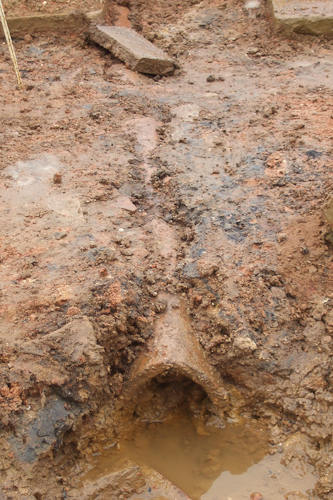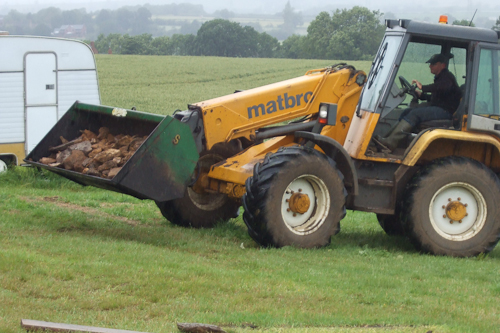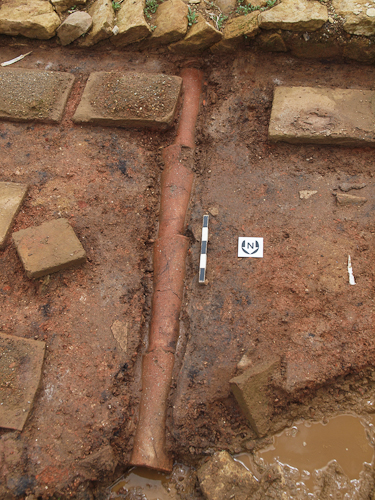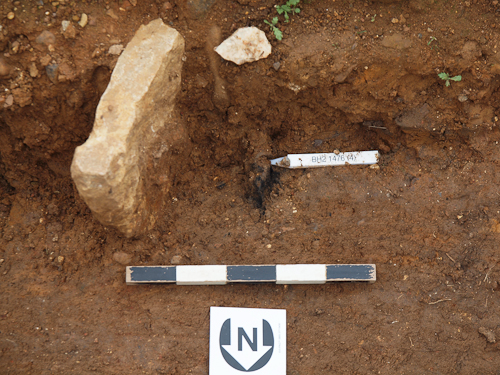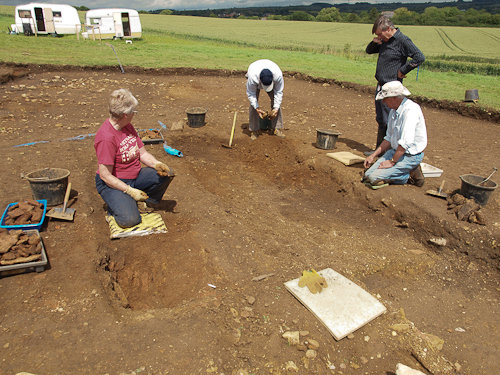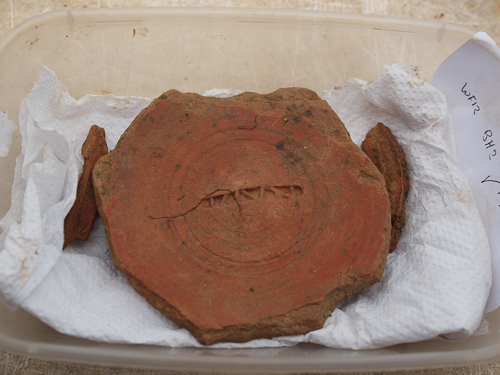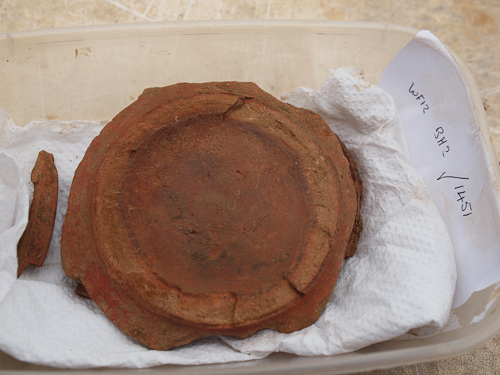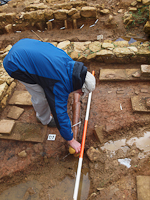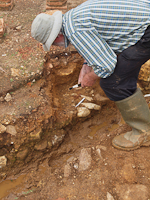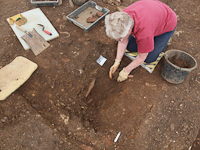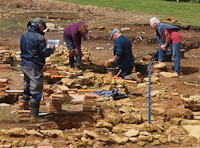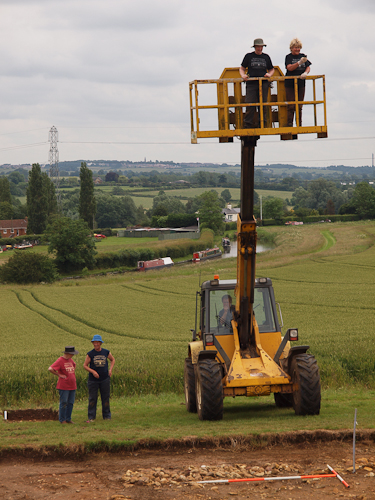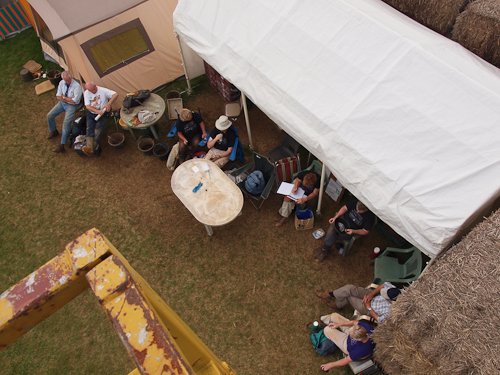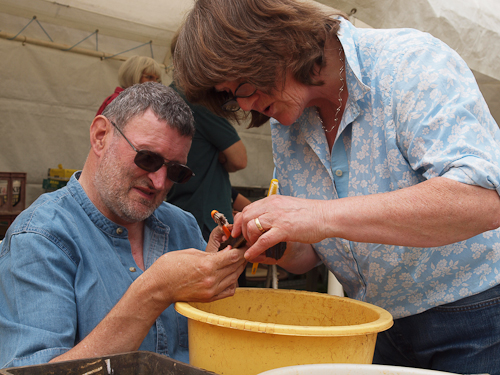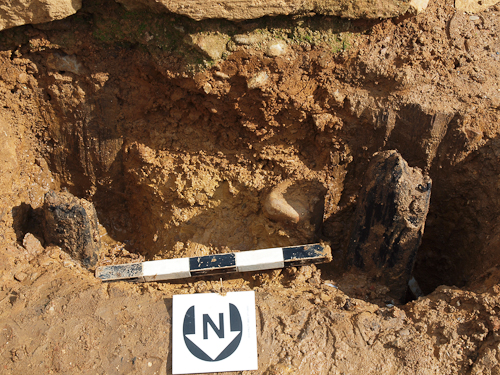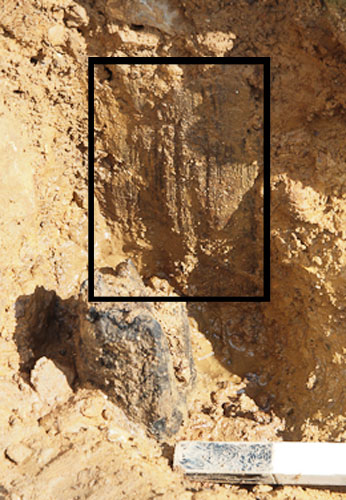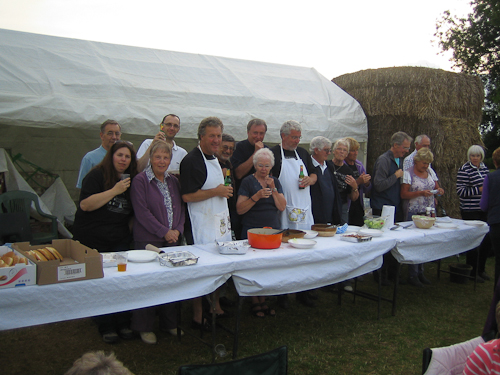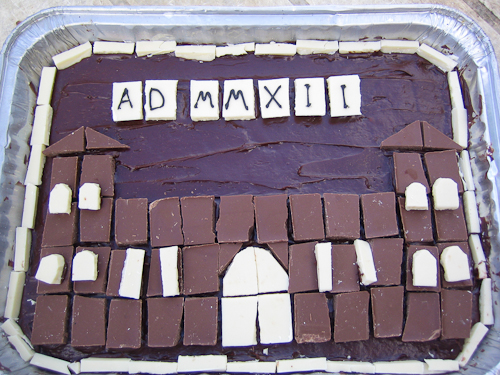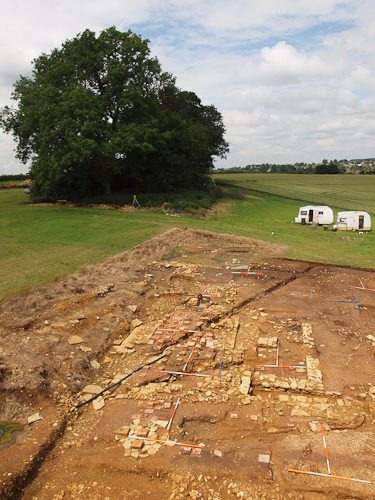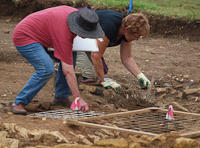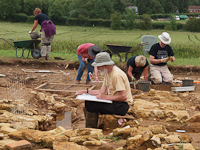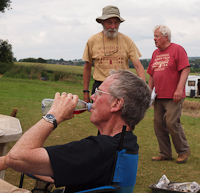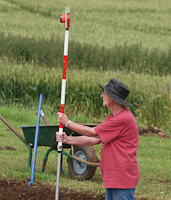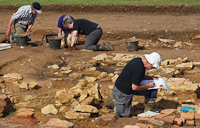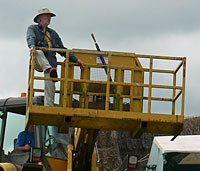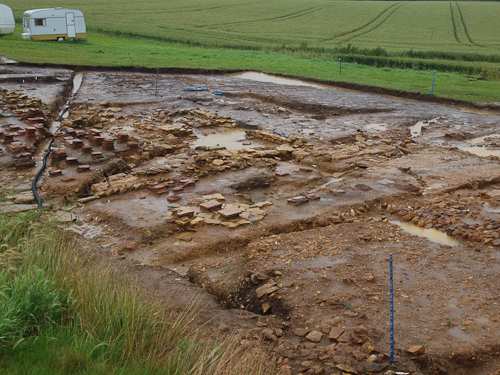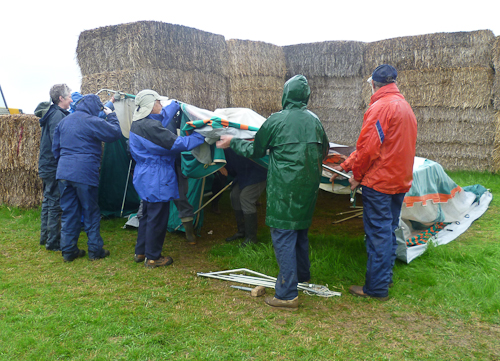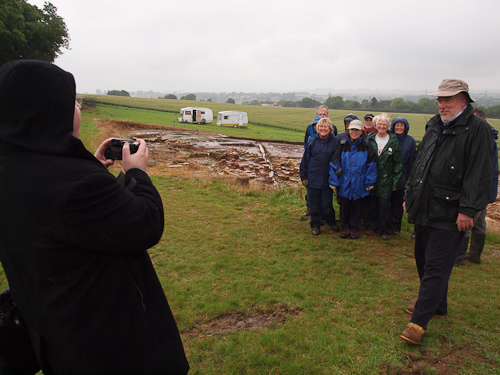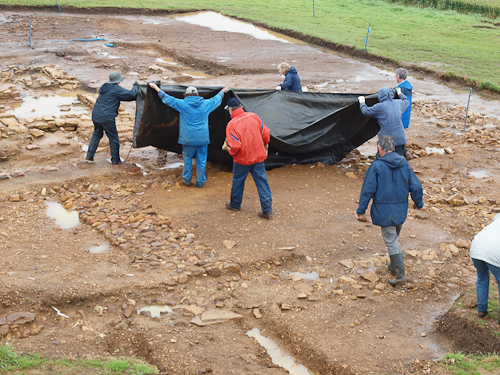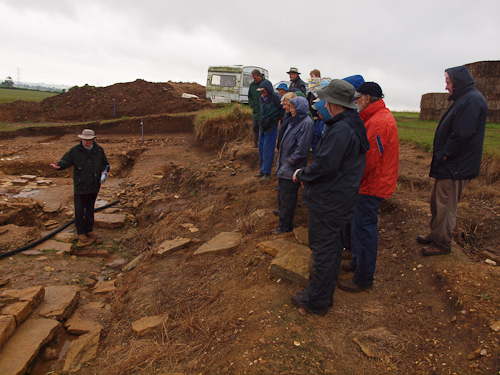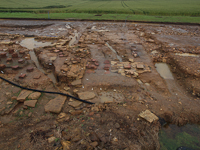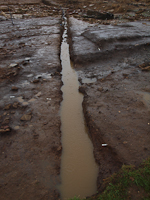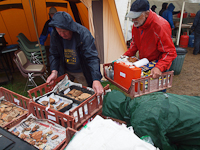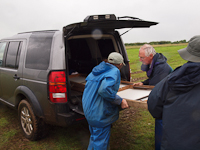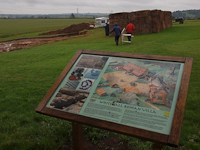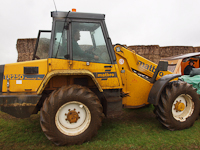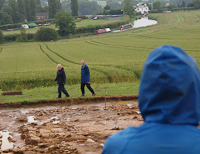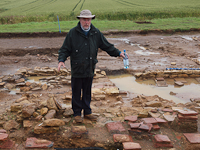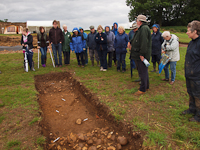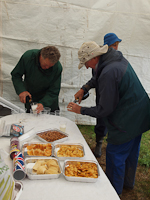 |
|
|||||
|
|
AN OCCASIONAL PROGRESS REPORT WEEK 4 |
|||||
Day 16 of 20: Monday 2 July This from Malcolm: I was at the dig today and what a washout it was. However, I managed a few pictures. No.1 is a general view of the site from the shelter of the voluteers' tent:
No.2 is a view of the new drain - a genuine roman period one - as can be seen by its presence under the floor of a heated room (see Wednesday's blog for a later view):
No.3 Richard brought the Matbro down and removed the stones which had previously filled the post medieval drain which runs diagonally across the site:
Meanwhile, in Milton Keynes, my wife and I visited the Central Library where we found a photo of Fred with the magnetometer at Bury Field Common back in May:
The label on the photo lists the culprits from right to left which might lead people to think that Fred is a bit younger than he is and wears a purple coat. Mmm. "Summer of Culture" doesn't have quite the ring of "Summer of Love" (sadly, I do remember the 60s), but is perhaps more appropriate to the weather. |
||||||
Day 17 of 20: Tuesday 3 July This from Rick: No photo's I'm afraid. (See tommorow's blog for some relevent ones).The day wasn't as hard as it was the day before due to the weather being a bit kinder, if still wet. |
|
|||||
Day 18 of 20: Wednesday 4 July Quite a pleasant day on site (at least it was while I was there around lunchtime). The most visually exciting feature on site is undoubtedly the drain pipe in room 7: Four segments designed to fit into each other - although the one nearest the camera seems to have been fitted the wrong way round! Here's where the pipe empties out into the drain between rooms 5 and 7:
Remember the line of sevenposts/post-holes/upright stones along the north facing outside of the wall of room 5 ...
... here's a close-up of one of them, with a post still in it:
Below is the area east of room 7 which has yielded so many bits and pieces:
The larger excavation on the right - with Norman kneeling in obeisance to it - is the one Rick referred to yesterday: Turning out to be a demolition layer it produced some of the best finds... a complete base of samian complete with makers stamp that I had been ignoring as it looked like another piece of roof tile. The stamp looks like it may say NAVI, which may indicate Navillianus, but its a very fragile piece and needs looking at. Later Rick sent me a revision of his first diagnosis: That last piece of stamped pottery was Oxford red slipped ware, not samian.Not much work done on that...yet... Here it is:
Otherwise today, Pam brought along two excellent cakes to share (thanks), Beryl practiced erecting her rather unusual tent (see photo on right - it does get much taller than that!) and Bob Diamond discovered Higgs Boson, even though it he didn't know about all the illicit activity of his underlings - heigh ho. Depending on the weather, we'll be shooting the end-of-dig high-level shots tomorrow. Yippee - more goes in the Matbro cage. STOP PRESS: This from Fred: Hi Jeremy
|
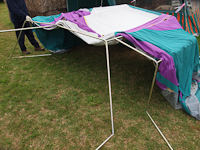 |
|||||
|
Day 19 of 20: Thursday 5 July In spite of showers forecast, this was a lovely day, if a bit humid. The sun was shyly hidden behind light cloud for much of the time, making the light perfect for photography most of the time with no strong shadows. Just after 11.30 we started about 90 minutes of high-level shots from the Matbro. Just before I had my go, Nick gave rides to others:
I took the best part of 200 hundred digital shots, and about 100 on black and white film (still standard for archaeology archival purposes!). Here's one photo to be going on with:
CLICK HERE FOR A GALLERY OF 31 HIGH-LEVEL PHOTOS And here's what the temporarily redundant digging crew looked like from above:
Some attention from the media today - Martin Heath of BBC Radio Northampton was given a site tour, recorded some actuality and then went aloft with Steve to record a his interview. Steve showed him the R-potbase as well. Listen to the result here! (4 minutes)
Meanwhile, back at ground level, Pip and Iain made their annual visit and helped by washing some cow bones. Great to see them both again:
Remember that line of post holes (again!) on the outside of the north wall of room 5? Of course you do! Well, further excavation today moved us a lot closer to understanding what the structure was here:
These are the two posts at the West end of the row (the far end in yesterday's photo). Behind each blackish post there is the clear imprint of a flat, vertical wooden surface in the soil:
So it looks as though the posts we have were related to (were holding in place?) vertical planks, which, presumably, formed an outer covering to the wall. Intriguing. Finally I captured this opportunity for you all to use a planning grid to sketch Fred's magnificent profile:
It was the barbecue tonight. This from Margaret: A few snaps taken last at the Barbeque. The weather was perfect and a good time was had by all. Cake baked by Sarah – it was delicious.
Thanks Margaret. I have a suspicion that tomorrow - the final, final day - may well be a washout, so let me leave you today with an iconic view of the site as we left it today, with fairly fluffy clouds behind the horse chestnut trees:
Goodnight. |
|
|||||
Day 20 of 20: Friday 6 July THE LAST DAY, EVER
Well the last day turned out to be as forecast - that is, much the same as the first day - a complete washout as far as archaeology was concerned.
This from Sandra from the morning: Here is the demise of the famous French Green Tent which has always been such a nightmare to put up.
We consigned it to a green recycling sack, next stop the Tip. However it appears to be having its revenge by trapping at least three people underneath it as it comes down for the last time.
As I arrived, a local journalist was taking a group photo:
The afternoon was spent moving finds and fittings to their various storage places:
Then the mosaic was covered ...
... while Steve and Dave carried on plotting in Steve's HQ:
At about 4pm we all gathered for the last roundup, and I took the tradiitonal end of dig photo:
The final site tour began:
Steve was in fine form, in spite of his very nasty cough, and he outlined his interpretation of the site. What follows is my understanding of what he said - as mentioned before, I may get it wrong! And Steve emphasised that this is no more than a coherent and credible interpretation based on the available evidence: we can never be completely sure of exactly what happened! CLICK HERE for my incredibly crude graphic, which has not had Steve's approval This year's dig had established that the earliest stage of BH2 was a 3rd century suit of rooms including those along the south end of the site, and three rooms now covered by the later hypocausts. The praefurnum in room 4 would have served the early stage rooms (11, 12 and 13) now lying under rooms 2, 3 and 4 (with the visible hypocaust system). It would be possible to find out more about the earliest stage rooms by taking out the pilae and their floor, but Steve is not willing to do this: the pilae represent a significant survival and he would rather leave it intact for any future generations of archaeologists who might want to uncover it again. In the 3rd century the bath house was one of the facilities of a large latifundium owned by a senior romano-british citizen. Elsewhere on the site were the round houses either end of the villa - but not the villa itself. The villa was built later to service the bath house - NOT the other way round!! During the 4th century, the bath house was altered by the building of rooms 2, 3 and 4, and later room 7, all with hypocausts. At this time the economy of the area changed, the latifundium probably was broken up, and our Whitehall site became an estate in its own right. The villa was expanded and, eventually, BH1 was built to replace the now damp and redundant BH2. The boundary wall between the BH2 and the crop may be enclosing the bath house site, or the larger enclosure, or (and here's the rub) something beyond it under the crops. Could it be the roman cemetery which Steve has been itching to find all along??? In November there will be meeting for anyone interested to hear what Steve has to say to bring the Whitehall VIlla story right up to date: look out on this website and the CLASP website for the details. The afternoon ended with a celebratory/commiseratory drink (champers) and nibbles provided by Nick:
After the walkround, the prosecco and the appreciation for all concerned, I left to get warm. Opened the field gate and was about to get back into the car when a ewe bolted from nowhere past me into the yard. I tried to locate Nick's number on my mobile while going to close the gate to the road, then back to close the field gate, still trying to be friendly and unthreatening to the ewe. Nick said Dave the Context was on his way down and would help. I suddenly thought to turn my abandoned car engine off. Not being a wolf or sheepdog, there wasn't much else to do except offer the ewe a bit of old hay which she didn't fancy. Dave and the 2 Tonies arrived, and the ewe decided she'd rather be in the field with the others. But Dave said in passing that Nick was laughing his head off. Probably not quite true, but I'm glad to have provided a comedy ending. But, Nick, you're on your own for the next round up. WHAT NEXT? In September the whole site will be infilled and returned to pasture. Before then Steve hopes to make one or two more minor investigations on the site. After that Steve still wants to investigate various aspects of the Whitehall landscape: the enclosure ditches; a couple of trial trenches in the cropped area after the harvest - if the cemetery is found, a major excavation could ensue; more work at the anglo-saxon cemetery - was that built next to a roman one? Beyond Whitehall, Bannaventa and other CLASP projects beckon. So dry your end-of-dig tears and look forward to a bright future delving into the past. AND FINALLY If you have been, thanks for reading, and thanks too for all the photos and copy diggers have sent in, not just this year but over the years. Thanks to all on site for being willing to be photographed and for tolerating my humour. This blog has appeared every year from 2005 to now, and I'll blog again if the occasion arises and there is significant activity to report. Meanwhile I'll guard assiduously the 17,000 or so files I have of Whitehall photos (they are well backed up!), and leave you for the time being with this image, which is one of the very first I took in 2000. It shows not only Steve talking to Dave Derby (one of the two metal detectorists who discovered the site) but also the focal point of the wonderful view, which I know I will miss. Until next time - farewell. |
|
|||||
Now where's that glass of wine? |
||||||
PS This from Rick on Saturday: As always, a lifeline to those of us who unfortunately can't make it up to the full 4 weeks of the dig, the blog keeps us updated and provides a good insight into what everyone else is doing. Well, perhaps excepting Fred. I started on this project ten years ago, not having any experience, but always having a love for archaeology. I remember getting shouted at by Steve for brushing back a surface which should have been trowelled back. (We had to do it again). I remember trowelling between the bunter pebbles of the courtyard, tedious to say the least, but finding part of a shale bracelet, only to find another part of it the next year on the same surface. Finding a complete window pane, if a little broken. Most of all I remember standing at the top of the site when we had stormy showers with shovel in hand with Steve and Context Dave during one stormy summer. A very black, tall storm cloud seemed to be approaching and we weren't sure if it was coming our way. I chucked some grass into the air and it blew the other way, away from us. The clouds kept coming towad the site and it was at tis point we realised I was the updraught sucking up the air from below. We decided evacuation was the better part of valour. It's not my full time work(which pays the bills), but my time at Whitehall has led me to pursue an interest in Samian, getting involved with the major players in the field and developing an interest into a speciality. I've got to thank Steve for that for having an element of trust in me. I'm going to have a beer now (Oh, and that last piece of stamped pottery was Oxford red slipped ware, not samian.Not much work done on that...yet...) There is now a "Memories of Whitehall" page on this website: Rick's message is alao posted there, to kick the page off. Let me have anything you'd like to share and I'll post it. |
||||||
| ||||||

